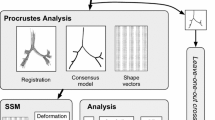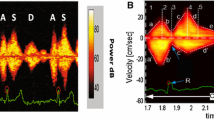Abstract
Pulmonary Hypertension (PH) is a progressive condition affecting the right heart, defined by a mean pulmonary arterial pressure (mPAP) greater than 20 mmHg. Measuring mPAP with a pressure catheter is the gold standard for diagnosing PH despite its associated costs and risks. As an alternative, this work investigates the inference of mPAP from pulmonary vasculature anatomy. We thus studied the shape of the main pulmonary artery trunk along with its left and right branches (MPA, LPA, and RPA) across a population of group I PH patients and investigated the relationship between shape and mPAP. Computed Tomography images from 80 confirmed PH cases were used to create a statistical shape model: anatomy was manually segmented, represented by 3 centerlines and radii at evenly spaced control points, and reduced in dimensionality by Principal Component Analysis (PCA). The correlation between each PCA mode of variation and mPAP was then used to identify relevant shape features associated with elevated pressure, which were finally combined in a linear regression model. Results reveal that changes in MPA’s diameter and bulging, as well as in the angle between RPA and LPA, related to mPAP. A linear combination of the first 12 modes, with a cumulative variance of 95%, resulted in a linear regression model explaining 36% of mPAP variability in the population, while a combination of the 6 most relevant PCA modes was able to explain 34% of mPAP variability. These results provide initial evidence of the ability to infer mPAP from pulmonary arteries anatomy in PH patients.
Access this chapter
Tax calculation will be finalised at checkout
Purchases are for personal use only
Similar content being viewed by others
References
3D slicer. https://www.slicer.org/
Antiga, L., Piccinelli, M., Botti, L., Ene-Iordache, B., Remuzzi, A., Steinman, D.A.: An image-based modeling framework for patient-specific computational hemodynamics. Med. Biol. Eng. Comput. 46(11), 1097–1112 (2008). https://doi.org/10.1007/s11517-008-0420-1
Bruse, J.L., et al.: How successful is successful? Aortic arch shape after successful aortic coarctation repair correlates with left ventricular function. J. Thorac. Cardiovasc. Surg. 153(2), 418–427 (2017). https://doi.org/10.1016/j.jtcvs.2016.09.018
Bruse, J.L., et al.: A statistical shape modelling framework to extract 3D shape biomarkers from medical imaging data: assessing arch morphology of repaired coarctation of the aorta. BMC Med. Imaging 16(1), 1–19 (2016). https://doi.org/10.1186/s12880-016-0142-z
Corral-Acero, J., et al.: The ‘Digital Twin’ to enable the vision of precision cardiology. Eur. Heart J. 1–11 (2020). https://doi.org/10.1093/eurheartj/ehaa159
Fedorov, A., et al.: 3D slicer as an image computing platform for the quantitative imaging network. Magn. Reson. Imaging 30(9), 1323–1341 (2012)
Gewers, F.L., et al.: Principal component analysis: a natural approach to data exploration. ACM Comput. Surv. 54(4), 1–33 (2021). https://doi.org/10.1145/3447755
Hermida, U., et al.: Learning the hidden signature of fetal arch anatomy: a three-dimensional shape analysis in suspected coarctation. J. Cardiovasc. Transl. Res. (2022). https://doi.org/10.1007/s12265-022-10335-9
Hermida, U., et al.: Left ventricular anatomy in obstructive hypertrophic cardiomyopathy: beyond basal septal hypertrophy. Eur. Heart J. Cardiovasc. Imaging 24(6), 807–818 (2023). https://doi.org/10.1093/ehjci/jeac233
Kholwadwala, D., Parnell, V.A., Cooper, R.S.: Transposition of the great arteries S, D, D and absent proximal left pulmonary artery. Cardiol. Young 5(2), 199–201 (1995). https://doi.org/10.1017/S1047951100011847
Lee, S.L., et al.: Spatial orientation and morphology of the pulmonary artery: relevance to optimising design and positioning of a continuous pressure monitoring device. J. Cardiovasc. Transl. Res. 9(3), 239–248 (2016). https://doi.org/10.1007/s12265-016-9690-4
Lewandowski, A.J., et al.: Preterm heart in adult life: cardiovascular magnetic resonance reveals distinct differences in left ventricular mass, geometry, and function. Circulation 127(2), 197–206 (2013). https://doi.org/10.1161/CIRCULATIONAHA.112.126920
Nakaya, T., et al.: Right ventriculo-pulmonary arterial uncoupling and poor outcomes in pulmonary arterial hypertension. Pulm. Circ. 10, 2045894020957223 (2020)
Pedregosa, F., et al.: Scikit-learn: machine learning in Python. J. Mach. Learn. Res. 12, 2825–2830 (2011)
Piccinelli, M., Veneziani, A., Steinman, D.A., Remuzzi, A., Antiga, L.: A framework for geometric analysis of vascular structures: application to cerebral aneurysms. IEEE Trans. Med. Imaging 28(8), 1141–1155 (2009). https://doi.org/10.1109/TMI.2009.2021652
Reiter, G., et al.: Magnetic resonance derived 3-dimensional blood flow patterns in the main pulmonary artery as a marker of pulmonary hypertension and a measure of elevated mean pulmonary arterial pressure. Circ. Cardiovasc. Imaging 1(1), 23–30 (2008)
Schroeder, W.J., Martin, K.M.: The Visualization Toolkit. No. July, Kitware, 4th edn. (2006). https://doi.org/10.1016/B978-012387582-2/50032-0
Vanderpool, R.R., et al.: Surfing the right ventricular pressure waveform: methods to assess global, systolic and diastolic RV function from a clinical right heart catheterization. Pulm. Circ. 10, 1–11 (2020)
Varela, M., et al.: Novel computational analysis of left atrial anatomy improves prediction of atrial fibrillation recurrence after ablation. Front. Physiol. 8(FEB), 68 (2017). https://doi.org/10.3389/fphys.2017.00068
Author information
Authors and Affiliations
Corresponding author
Editor information
Editors and Affiliations
Rights and permissions
Copyright information
© 2024 The Author(s), under exclusive license to Springer Nature Switzerland AG
About this paper
Cite this paper
Sabry, M. et al. (2024). Exploring the Relationship Between Pulmonary Artery Shape and Pressure in Pulmonary Hypertension: A Statistical Shape Analysis Study. In: Camara, O., et al. Statistical Atlases and Computational Models of the Heart. Regular and CMRxRecon Challenge Papers. STACOM 2023. Lecture Notes in Computer Science, vol 14507. Springer, Cham. https://doi.org/10.1007/978-3-031-52448-6_18
Download citation
DOI: https://doi.org/10.1007/978-3-031-52448-6_18
Published:
Publisher Name: Springer, Cham
Print ISBN: 978-3-031-52447-9
Online ISBN: 978-3-031-52448-6
eBook Packages: Computer ScienceComputer Science (R0)




